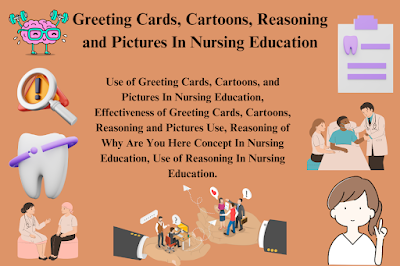Reasoning and Pictures In Nursing Education Introduction
In nursing education, the integration of non-traditional teaching aids such as greeting cards, cartoons, and pictures can significantly enhance the learning experience. These tools not only foster engagement but also stimulate interest and creativity among students. Additionally, strategies like the “Why Are You Here?” concept help educators tap into student motivations, promoting a deeper connection to course content. This article outlines the use and effectiveness of these strategies in nursing education, providing insights on how to incorporate them effectively.
Use of Greeting Cards, Cartoons, and Pictures in Nursing Education
General Description
Nurse educators widely embrace the use of visual and humorous materials, including greeting cards, cartoons, and pictures, to create a welcoming and engaging classroom environment. This strategy involves the careful selection of light-hearted, yet relevant, materials that align with course content and maintain professionalism. Whether it’s a humorous cartoon or a thought-provoking picture, these materials help to set a positive tone and stimulate discussion from the very beginning of a class.
Preparation and Equipment
Implementing this strategy requires an educator to constantly be on the lookout for appropriate materials, whether online or in print. Greeting cards, cartoons, or relevant photos can be found in calendars, magazines, or even on social media. When using such materials, it is essential to ensure that they comply with copyright laws and that any external materials are used under fair use guidelines. Scanning, photocopying, or creating PowerPoint slides featuring these materials are common methods of preparation, but proper credit must be given to the creators.
Example of the Strategy at Work
An example of this strategy can be seen in the use of a humorous joke or cartoon as an icebreaker. For instance, showing a funny cartoon about a frog requesting a loan (with the punchline “It’s a knickknack, Patty Whack. Give the frog a loan. His old man’s a Rolling Stone!”) lightens the atmosphere, helping students feel more relaxed and open to learning.
Effectiveness of Greeting Cards, Cartoons, and Pictures
The use of greeting cards, cartoons, and pictures can effectively break up sections of a lecture, serving as transitions between topics or as brief mental breaks. These visual tools can also be used in the middle of lectures to re-engage students’ attention or to emphasize key points. The effectiveness of this strategy, however, hinges on the discretion of the educator in selecting appropriate content that is culturally sensitive and relevant to the class.
Photos, especially personal ones, can enhance the learning experience when used in a way that aligns with course objectives. For example, an educator might share a photo from their nursing career to illustrate a real-world application of theoretical concepts.
Instructors must be cautious about the use of humor, avoiding content that might alienate or offend students. The primary goal of this strategy is to stimulate interest and reinforce learning in a way that complements the academic material, without distracting from the core objectives.
Reasoning of the “Why Are You Here?” Concept in Nursing Education
General Description
The “Why Are You Here?” strategy is a simple yet profound way of gauging student motivation and aligning course content with their goals. At the start of a class or semester, instructors ask this question to explore the students’ internal versus external motivations for attending the course. Understanding student motivations helps the educator tailor the class experience to better meet student needs.
This method also sets the stage for clear communication between the instructor and students about course objectives and expectations, helping ensure that the material covered aligns with the students’ personal and professional goals.
Example of the Strategy at Work
An instructor might start a class by displaying the question, “Why Are You Here?” on the screen and asking students to share their reasons for attending. Responses can vary from external motivations like, “Because my manager told me to,” to more intrinsic reasons like, “I want to improve my nursing skills.”
Discussing these responses opens a dialogue, allowing the instructor to adjust class content to better address the students’ expectations. It also enables students to reflect on their goals, enhancing their engagement with the course.
Use of Reasoning in Nursing Education
This strategy doesn’t require elaborate preparation—only a reminder to ask the question at the start of class. Educators can record student responses on a flip chart and revisit these responses at the end of the session to assess whether the class objectives have been met. For students who may be less motivated, this strategy offers an opportunity to inspire interest by connecting course content to real-world nursing challenges or career advancement.
Practical Tips for Using the “Why Are You Here?” Strategy
- Flipchart Record: Writing down students’ reasons for attending can serve as a point of reflection at the end of class. It also provides a visual cue for ensuring all key topics have been addressed.
- Low-Motivation Classes: In classes with low motivation (e.g., mandatory courses), this strategy can be particularly valuable. It gives educators a chance to use creative strategies to instill motivation and explain why certain topics are essential for nursing practice.
- Instructor Engagement: By sharing their own reasons for teaching the course—such as a passion for nursing education or a commitment to student success—educators can model enthusiasm, motivating students to engage more deeply with the material.
Conclusion
Incorporating greeting cards, cartoons, pictures, and reasoning strategies like “Why Are You Here?” into nursing education enhances both student engagement and learning outcomes. These tools foster a positive and interactive classroom environment, stimulate critical thinking, and help students connect course material to their personal goals. By understanding and leveraging student motivations, educators can tailor their teaching strategies to improve both student satisfaction and academic success.
